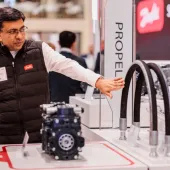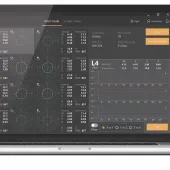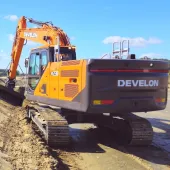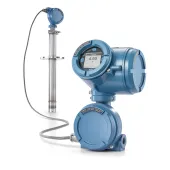Intelligent Control and Monitoring of Feed Into Crushing and Screening Operations

First published in the September 2014 issue of Quarry Management as Smart Control
Intelligent control and monitoring of feed into crushing/screening operations can increase throughput and product quality whilst improving operator occupational health, safety and well-being. Quarry control specialists Cantech explain how
Latest-generation control of a complete crushing and screening plant can now readily be conducted remotely from a centralized control room or weighbridge office at a quarry, including any or all of the primary, secondary and tertiary crushing processes. This not only offers opportunities to reduce production costs, but also wider benefits to producers, staff and customers alike, as explored below.
Faster/optimized production
Whilst almost all operations strive to maximize production, this does not necessarily mean running the plant at its nominal maximum capacity all the time. Instead, maximum tonnage over a period can often be achieved by ensuring that the process operates at the most appropriate rate given the nature of the quarried material at the time, ie not overfeeding one section of a plant relative to another and thereby avoiding blockages, spillage, tripping of items on overload etc which can otherwise result from overfeeding, particularly arising from changes in the composition of the raw product being fed into the plant.
A good control system will continuously monitor plant performance, for example: reading the rate of passage of material through sections of the plant using beltweighers; measuring the current drawn by crushers and screens; or using level sensors to monitor the contents of surge hoppers or even final storage bins. Not only will this information be continuously provided to the operator, but, crucially, the system will adjust the process automatically, typically controlling the rate of delivery into the plant by changing the speed or extent of vibration of an incoming feeder, to keep these measured flow rates, currents and/or levels at or close to their required settings.
This ensures that the plant is automatically kept at its optimum performance, maintaining high throughput whilst minimizing downtime as well as often reducing excessive wear and tear on the plant.
A high production rate combined with reliability in the expected output from the plant benefits both producers and their customers, both of whom can have confidence that the ordered loads will arrive with less susceptibility to breakdowns and interruptions. It can also reduce stress on staff to repair and clean up under pressure following a breakdown, and limit friction between management and staff over possible causes.
Consistently high product quality: full data records
Maintaining a consistent feed rate over screens also helps to ensure the quality of final product nominal sizes: this is further improved on a sand/gravel processing plant by continuously monitoring the density of the sand/water and adjusting the flow of water into and sand out of the plant to optimize the quality of the sand produced.
Furthermore, details of the production process can be continuously recorded on PC disk files, allowing records of production rates, running times of motors and other key performance indicators to be examined by the technical or management teams at a later time or whenever such information is required. This is a key benefit in that it allows bottlenecks to be seen and maintenance requirements and/or potential plant improvements to be identified. This information can also be made available in other locations well away from the quarry itself, eg regional offices or head offices, via broadband connections.
Remote operation: centralized control
Recent years have seen an increasing drive to move the point of control away from the plant itself, removing the need for a manned control room close to the plant, primarily for one or both of the following reasons:
1. Operator health, safety and well-being
Providing control from a clean control room or weighbridge office away from the plant itself removes the operator from the dust, noise, vibration and heavy vehicle movements typically encountered in conventional on-plant control rooms.
One notable recent example involved remote operation of a rock-breaking process at the intake to a primary crusher, which had previously required an operator to be stationed all day in a small cabin immediately adjacent to the crusher, but is now conducted with camera assistance from a clean weighbridge office at the entrance to the site, in line with the operating company’s drive to promote healthier working conditions and higher efficiency.
Furthermore, this often means that the plant operator can share an office with others, eg weighbridge clerks. Not only can they then work closely together, but this also provides a greater element of human interaction for the operators, rather than being somewhat isolated as can be the case with on-plant control. The benefit of this contact to an operator’s well-being should not be underestimated – the amount of radio chatter between operators and drivers of mobile plant and incoming trucks at a typical quarry operation bears this out.
2. Centralized control of more than one plant
The sophistication of monitoring and control that a comprehensive system provides means that the system will largely run itself, with the operator only having to intervene occasionally when prompted, eg when the system detects a problem. He/she can, therefore, be available to control another process, particularly if that process is controlled by a similar system.
One example of this combines control of a crushing/screening plant in the same office as an aggregate blending/loadout system, in which drivers report to the office to be allocated a load of either single-size or blended aggregates, the details of which are entered by the operator. The drivers are given a small remote handset (like a rugged version of a TV remote control) and proceed to the loadout plant where they press the handset, whereupon the system recognizes the handset code, recalls the details of the load as previously entered and loads the truck with the required material, without the driver getting out of the cab or even having to open a window. There is very little operator involvement in the loading process, apart from entering the initial details, and it is quite reasonable for the same person to be able to operate both the crushing/screening and loadout plants without being overworked, once basic training has been provided in the operation of both systems.
Greater flexibility of staffing: monitoring/control from mobile plant
Cantech’s experience has shown that most quarry operators learn the operation of their control systems reasonably quickly, which means that it is practical to train several people to use them. As a result there is less dependence on the skill of any one particular operator, thereby allowing the workload to be spread around to cover holidays and busy periods without anyone needing to work excessive hours.
Additionally, the use of wireless technology allows the installation of control stations in the cabs of mobile plant such as dumptrucks and loading shovels: this allows drivers to monitor the product levels in a set of final bins and to only take material from them as they become full, while leaving them free to conduct other tasks around the quarry for much of the time, instead of largely being tied to the one area of the plant.
Moreover, this same wireless unit will allow the dumptruck driver to initiate loading of material from the bins from within his/her cab, thus avoiding the need to get in and out and reducing the risk of slips/falls or even more serious injuries from other heavy vehicles.
Energy saving
As part of its general monitoring, an intelligent control system can detect when no material has passed over an incoming beltweigher for longer than a given period time (ie the plant is not being fed). It will switch off the incoming feeder(s) and then shut down the plant in a controlled sequence. This can result in reduced energy costs and helps avoid unnecessary wear and tear on the plant, as it is not left running for extended periods of time without producing.
Summary of the key benefits of smart control
- Plant throughput optimized and risk of surges/blockages/downtime minimized
- Intelligent feed control provides consistent feed across screens
- Remote control away from plant, removing operators from dust, noise and vibration
- Automatic plant shutdown to save energy when plant is inactive
- Recording of production rates, motor running times and other key performance data
- Wireless display allows safer and more efficient use of dumptrucks/loading shovels.
For further information visit: www.cantech-controls.com
- Subscribe to Quarry Management, the monthly journal for the mineral products industry, to read articles before they appear on Agg-Net








